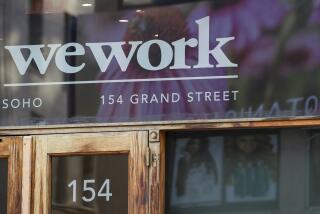Ashton-Tate, in About-Face, Sees a Loss
- Share via
After relying on overly optimistic sales projections for its personal computer software early this year, Ashton-Tate Corp. did a turnabout Tuesday and said it expects to report a loss of as much as $15 million and significantly reduced sales for the second quarter.
The Torrance company, the nation’s third-largest personal computer software publisher, said its problems could persist for several months and might also result in a third-quarter loss. Ashton-Tate’s stock fell sharply on the news, dropping $4.25 to close at $18.50 a share in heavy over-the-counter trading.
Ashton-Tate said its sales in the current quarter could be as low as $55 million, about 23% less than the $71.9 million it had in last year’s second period. Despite projecting the company’s first quarterly loss since early 1984, Chairman and Chief Executive Edward Esber said Ashton-Tate plans no layoffs or organizational changes.
Analysts blamed Ashton-Tate’s difficulties primarily on a sales technique commonly known as “channel stuffing.” They said the company’s use of this technique may have been designed to boost lackluster sales of the latest version of its top product, dBase database software.
Inventories Mount
Under this practice, which is considered fairly widespread in the industry, publishers typically offer distributors deep discounts on volume purchases in the final week of the quarter to boost revenue for the publishing house. Although distributors may not need all the products they buy, they purchase the discounted merchandise to maintain the business relationship and to take advantage of the special price. But if the distributor cannot sell the merchandise, inventories mount.
Acknowledging that channel stuffing contributed to the company’s problems, Esber said he became aware of the mounting oversupply of Ashton-Tate goods in February and began curtailing new shipments the next month, cutting the company’s revenue.
“We and our customers were overly optimistic,” he said. “We sold more product than users wanted.”
“What we did is an industry-wide practice,” Esber added. “Deals get made to get sales. But we have the biggest ‘kick me’ sign on our backs today.”
Esber said he believes the company’s problems started in the final months of 1988, just as it was releasing the latest version of its best-selling software, dBase IV, a software system that allows users to organize vast quantities of information. The dBase product line accounts for well over 50% of Ashton-Tate’s revenues.
dBase IV Lags Behind dBase III
Analysts have estimated that Ashton-Tate shipped as many as 300,000 copies of the new version amid high expectations for its success. However, according to Jeffrey Tarter, publisher of Soft Letter, a software marketing newsletter in Boston, dBase IV “hasn’t caught on as expected.” The program currently ranks 20th on the PC top-seller list published by one nationwide distributor, eight spaces behind dBase III, the program it was supposed to replace.
Esber declined to discuss the sales levels of the newest version, saying only that he expects sales to grow. Overall, he said, sales of all dBase programs generally “meet our expectations for the product family.”
However, analysts and users have complained that dBase IV has more than its share of flaws that hamper its performance, a charge Esber hotly denies. “Customers are just more cautious about going to the next generation of software,” he said.
More to Read
Inside the business of entertainment
The Wide Shot brings you news, analysis and insights on everything from streaming wars to production — and what it all means for the future.
You may occasionally receive promotional content from the Los Angeles Times.










